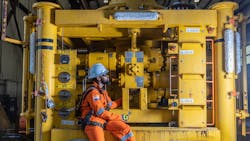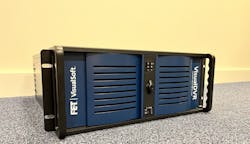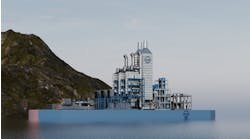Technology advances the clear focus at Subsea Tieback 2023
Editor's note: This article first appeared in the March-April issue of Offshore magazine. Click here to view the full issue.
By Ariana Hurtado, Editor and Director of Special Reports
The annual Subsea Tieback Forum & Exhibition was held Feb. 28 to March 2 in Galveston, Texas, and the conference chatter, filled with enthusiasm about the current state of the offshore sector, zeroed in on the latest technology developments. The following is a sampling of the subsea innovations highlighted among the nearly 80 exhibitors.
Subsea gate valves
Product performance and longevity are imperative in subsea operations due to costly time and personnel resources needed to surface the equipment for replacement or repair, according to Anand Kalimuthu, director of engineering with Worldwide Oilfield Machine Inc. (WOM).
"As water depths and pressures continue to increase, subsea gate valves must evolve accordingly to operate reliably in extreme environments and withstand harsh conditions," Kalimuthu told Offshore. "Social and environmental pressures relating to the energy transition are increasingly crucial in today’s market. The oil and gas industry is facing the challenge of simultaneously delivering increased operational performance with decreased emissions."
Traditional subsea gate valves offer varying degrees of performance and longevity in extreme conditions. "These operational factors are typically prioritized over ESG because of the high cost to develop new technology," he said.
WOM’s new Magnum XU subsea gate valve is the latest addition to its Magnum valve line, which Kalimuthu boasted has nearly 40 years of field-proven reliability. The Magnum XU valve evolved from this line as a low-weight, high-value alternative to conventional valves designed "to outlast and outperform the ordinary." The Magnum XU valve is designed to offer safer, more reliable performance with features such as dual sealing and Integral Hard Facing (IHF) technology. With 50% less steel and weight compared to conventional valves, it also provides substantially lower carbon footprint and logistical costs, he said.
The valve’s seats and gates coated with WOM’s IHF process provides durability of critical sealing surfaces. This process involves coating powder metallurgically bonded with the base material by WOM's spraying/fusing process to achieve the desired physical properties for performance and longevity. Other major original equipment manufacturers typically use high-velocity oxygen fuel (HVOF) coatings that remain as a separate coating layer. The WOM IHF has a higher coating thickness than conventional HVOF, which extends life of the valve and improves reliability, Bhaskar said.
The Magnum XU valve’s cavity design reduces internal volume and weight. Specifically, the rectangular body cavity allows for significantly less grease volume and 50% less weight than conventional valves. This directly reduces trucking costs and related logistics.
"It is still unknown how long and hard the Magnum XU valve can be pushed," Kalimuthu said. "It has already lasted four times longer than the industry standard, but we continue to push further. API standards for qualifying a valve design to a level of PR-2 requires 200 full differential valve cycles (valve operated while under pressure). This valve has exceeded 20,000 cycles, and both of the gate-to-seal seals are still holding high- and low-pressure tests. This endurance test perpetuates as we continue to push to its limits."
Subsea survey recording
Forum Energy Technologies’ (FET) has released a next-generation tool for the required video recording equipment for subsea survey and inspection.
Version 11 (V11) of VisualDVR, a digital video recorder produced by FET’s VisualSoft product line (originally launched in the early 2000s), was designed to offer enhanced technology and user experience. In common with its predecessors, VisualDVR (V11) is a multi-channel, rack mountable digital video system designed for use on ROVs, supporting activities in the energy, defense and ocean science sectors.
"The system can record up to four channels of HD video and is equipped with a host of tools and complementary applications to support real-time documentation of the video images with data from subsea sensors and inspection personnel," Kevin Taylor, FET's vice president of subsea vehicles, told Offshore. "As part of the update, V11’s user interface has been completely modernized. Configuration of recording quality, data paths, input and output profiles can be accessed easily, and channels can be developed in a simple step-by-step process. There are also new tools to flag potential setting conflicts while improvements have been made to allow video overlay set up to be simpler."
The new system is also supported by new hardware architecture. A motherboard and high-end graphics card have been chosen alongside a multi-channel video encoder card that has been selected for improved performance and reliability.
"The subsea sector can present complex and changing challenges, but the V11’s robust and capable hardware ensure the firm’s new software solution meets the demands," Taylor said. "With supply chain challenges plentiful, FET believes any necessary changes to its hardware architecture will be more easily implemented than with its legacy system."
Deepwater intervention
Sonardyne shared a deepwater intervention case study with Offshore, in which Trendsetter Vulcan Offshore (TVO) and Sonardyne collaborated on the use of subsea monitoring technology.
TVO was hired to help an operator fix a completed wellhead that had been bent at a deepwater site. The wellhead was in more than 2,000 m water depth, and there were concerns other components might have been damaged. TVO was tasked with bringing it back to a vertical position. This would allow intervention access to the well for remediation and abandonment operations, so it could be permanently sealed. A key challenge was to carry out this work while preventing any further potential damage to the wellhead.
TVO proposed a ring of six subsea tensioning systems, mounted on suction piles positioned in a ring on the seafloor around the wellhead. Each one would be connected via a rope to a TVO-supplied lower riser package (LRP) installed onto the wellhead. By carefully tensioning the ropes, they would be able to then bring the wellhead back into an upright position.
TVO deployed a wireless, intelligent, digital underwater monitoring tool that provided near-real-time inclination and tension data to the operations team at the surface (about three minutes delay). It comprised two of Sonardyne’s Subsea Monitoring, Analysis and Reporting Technology (SMART) and six Compatt 6 transponders. The internal inertial measurement unit in each SMART was used to calculate pitch and roll data from two points on either side of the LRP, allowing TVO to calculate the wellhead’s bend angle in the local coordinate frame. These data were then transmitted acoustically, using the SMART’s internal modem, to the surface at three-minute intervals. The Compatt 6s were interfaced with the load cell shackles at each tensioner point on the LRP and transmitted the tension readings to the surface at less than one-minute updates.
The righting operation took three hours, using an ROV to tension the winches at two key tensioning units, one at a time. In comparison, using the alternative methods would have taken days, according to Sonardyne. Throughout the project, the TVO team and the operator were able to view a constant near-real-time visualization of the inclination of the wellhead and the tension that was being applied at each tensioning system. This was done via a TVO-developed internet-based dashboard, so any member of the wider team, including the operator, could watch from anywhere in the world.
After righting the wellhead, the tensioning and monitoring system was kept in place to allow safe intervention and final abandonment operations to be completed, at which point the data transmission rates were reduced to once every few hours.





